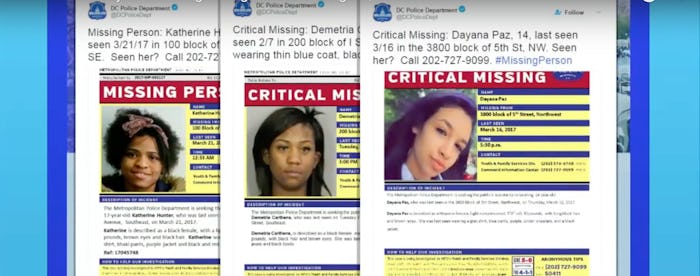Last week a viral tweet horrified the internet at large and started a very necessary conversation about race and law enforcement. When a tweet claimed that 14 young black girls had gone missing in Washington D.C. in the previous 24 hours, the internet at large was outraged. But the veracity of the information was muddled, and police in D.C. attempted to provide context for the girls' cases. Who are the missing D.C. girls? Several have been missing for years.
On March 23, a tweet referencing an Instagram post by Entertainment for Breakfast entitled 14 Girls Have Gone Missing in DC in the Last 24 Hours went viral. The original post has since been taken down, but the conversation it spawned has not. The claim made in the post, while horrifying, was immediately called out for being only partially accurate. New York Daily News writer Shaun King had recently done a story that featured the images in the post, according to BuzzFeed. King pointed out on Twitter that some of the girls — while they were missing — had not gone missing in the previous 24 hours. In fact, many of them had been missing for years, and not all of them went missing from D.C.
One of the girls, 8-year-old Relisha Tenau Rudd, went missing in March of 2014 and 16-year-old Derriana Hansford went missing on Christmas Eve of last year. Chareah Payne, 17, had also been included in the list but was located safe, according to police. There are also several juveniles missing from D.C. who are male. Since the beginning of 2017, at least 10 other young black women have gone missing from D.C.:
- 16 year-old Faith Nelson, last seen on January 30
- 17 year-old Demetria Carthens, last seen on February 7
- 15-year-old Chantese Zimmerman, last seen on February 16
- 15-year-old, Dashann Wallace, last seen on March 8
- 14-year-old Shaniah Boyd, last seen on March 18
- 14-year-old Seayauna Parker, last seen on March 23
- 16-year-old Rayna Gross, last seen on March 25
- 15-year-old Heaven Shamte, last seen on March 26
The Metropolitan Police Department in D.C. also weighed in, stating that it recently began posting more missing person's fliers on its social media, including Twitter, which probably made people think there were more missing persons cases as of late, according to NBC News. They also stated that the 14 girls had not gone missing in a single day; the statistics provided by the Metropolitan Police report that as of March 27, there are 14 active missing persons cases involving juveniles, three of which are considered to be non-critical.
The most recent juvenile on the list went missing on March 27: a 15-year-old named Leonna Lewis, described as "a black female, 5’3” tall, 130 pounds, with brown eyes, black hair, and a medium-brown complexion. Leonna was last seen wearing a black shirt, khaki pants, and gray shoes."
In fact, Lewis' description echoes that of many of the missing youth on D.C.'s list, which is one reason why the viral story took hold. Even though there were some garbled facts, it didn't change the fact that the majority of missing persons cases in the city involved black youth — and the public wanted to know why more wasn't being done to locate them.
Muriel E. Bowser, D.C.'s mayor, said on Friday that the city would devote more resources to the search not just for the girls in the original post, but all of the city's missing youth. A spokesperson for the mayor's office later told The Washington Post that the girls were more than likely runaways:
Often times, these girls are repeat runaways. So if we really want to help solve this problem and bring down the numbers, we have to break the cycle of young people, especially young girls, who repeatedly run away from home.
While many thought the characterization put the blame on the girls, the D.C. police's definition of "critical" missing person's includes runaways — especially those who have run away several times, and especially those who are underage, according to the Post. In fact, according to The Center for Missing and Exploited Children, runaways can be at a greater risk — since they may be fleeing abusive situations at home. Runaways are also vulnerable to being lured into gang activity, sex trafficking, or other exploitative and dangerous situations, according to The National Network for Youth.
The problem is, in the crucial early hours after someone goes missing, if they've been classified as a runaway, they may not get the same media coverage, including things like Amber Alerts. Natalie Wilson, co-founder of the Black and Missing Foundation, told USA Today that a lot of black children that go missing "are initially classified as runaways" — meaning they may not get that critical widespread coverage early on.
That point is further emphasized by the 14 girls in the viral post. The story was bad enough when the internet thought they'd gone missing recently, but the truth is even more heartbreaking — and should be enraging. The young black girls in the viral post have been missing for days, weeks, months, and in some cases, years — yet last week was the first time most of the country had heard their names.
For a complete and daily updated list of missing persons in Washington D.C., visit the Metropolitan Police Department's website.
For nationwide missing persons cases involving youth, including Amber Alerts, visit The National Center for Missing and Exploited Children.
